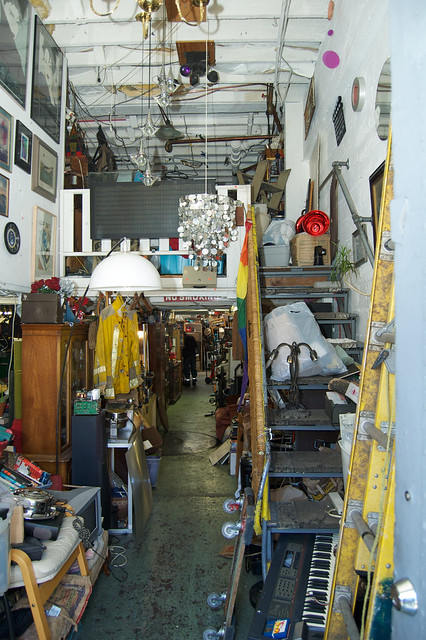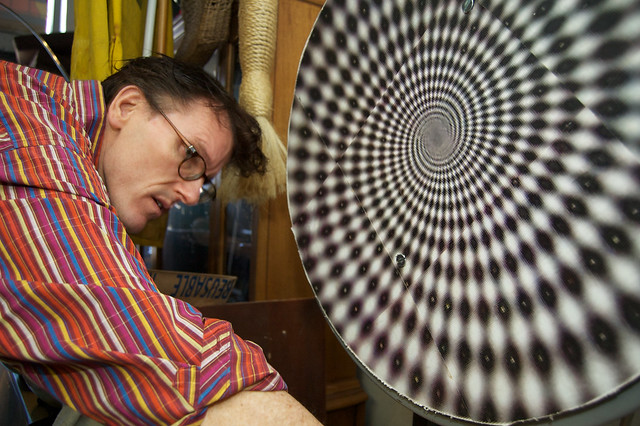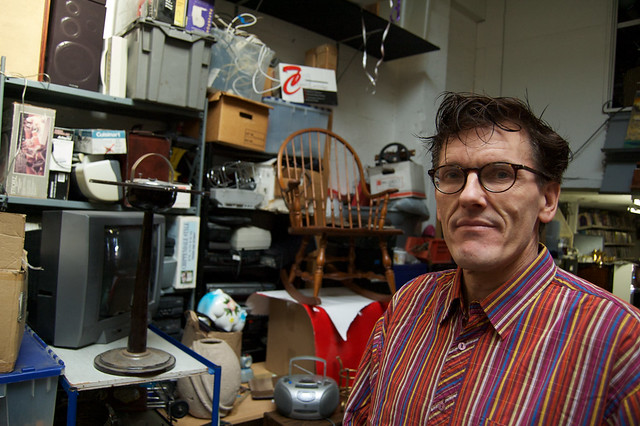“Where exactly are we going?” Jonathan asks.
“The Moving Sale,” Giovan says, stepping out of the staircase to his apartment and on to the pavement, zipping his windbreaker all the way up to the brown tuft of hair hanging off his chin. “Imagine every garage sale you’ve ever been to stacked in a warehouse.”
Jonathan Sanders, 22, is up from Los Angeles with a few friends, staying with San Francisco State University student Giovan Alonzi, 21, at his quaint SoMa apartment. A good rest after a day consumed by transit, Jonathan is ready to absorb what San Francisco has to offer. And this afternoon, after about a week of rainfall, the washed pavement and cool colors that paint the south of Market skyline seem to glow, illuminating this chilly, but bright path up 5th Street and down Howard Street.
And Giovan is not far from the truth. Small bookshelves filled with idiot’s guides and tattered spy novels, French-American dictionaries, toasters, tables, and chairs sit outside on the street, where most of them had been left in the first place, only to be gathered and appropriated for curious and thrifty urban dwellers. They do not obstruct the path so much as they guide the eye into the endearing warehouse on the right, from which they seem to be spewing out.
Upon entry, the midday light falls through the open door on Howard Street lighting up the hallway surrounded by chairs, cushions, DVDs, 50-year-old credit card mProxy-Connection: keep-alive
Cache-Control: max-age=0
hines, and all sorts of knicks and knacks by the time it stops at the beginning of the main room of the live-work space. Piles of furniture, televisions, a piano, and the faded books, given a subtle coloring and character by the lamps hanging overhead and stationed around the room, are all for sale, validating the sign that hangs above the door: “It’s not just a garage sale, it’s the whole house.”
Rhythmic echoes of rummaging come to an end and shortly after, store owner Mark Swenson steps into the light leading into the warehouse’s main space, decked out to the ceiling in antiquity. His protruding chin accentuates his grin at the sight of Giovan, who is at this point a regular.
Giovan first stumbled upon this place in December, and, for less than $35, bought Christmas gifts for his roommates and entire family. Ralph Bakshi’s lesser-known Lord of the Rings, a decadent olive oil-vinegar dispenser, a jello mold, Plato’s Ethics, and an old framed Yamato-e are stacked in his arms by the time he exits onto the street, only to return with friends several times over.
Swenson, now 48, moved to San Francisco in the late 1980s after graduating with a degree in Communications from the University of Minnesota. The son of an apartment manager, he spent his whole life in Minneapolis, learning electrical and repair skills he would later put to use. His social skills finally bloomed in college when he became a representative for his fraternity, and he could realize his passion for people. Dreams of entering the entertainment business brought him to California, first shacking up in San Francisco, where he worked selling hot dogs on a street corner.
“Best job I ever had,” Swenson smiles, taking off an examining the perfect round lenses on his glasses, legs crossed and knee bouncing. “I loved it because I could just stand there and talk to tourists all day. This was years ago when only one company had all the permits to sell so they had like five or six carts throughout the city.”
In 1989 he found himself in Los Angeles selling Ricoh and Xerox copy machines, where he first learned how to sell. Still feeding his fondness for showbiz, he specialized in production and entertainment accounts, and it was about this time that a client in the business helped him land a gig as an extra on several episodes of Cheers.
“And I was on The Love Connection,” he laughs. “I was on the Scrabble gameshow and I actually won. It was weird because they said if you win, you’re going get your check 90 days from the air date. Don’t call us on day 89 on day 90 you’ll get it. And on day 90, $500 came in the mail. It was amazing.”
Several years into the 1990s, Swenson moved back to San Francisco, working at Macy’s, selling men’s shirts and ties. An accident on the job required him to take leave on workman’s compensation for several months, and during that time what would eventually become The Moving Sale is conceived.
“I had picked up a piece of furniture on the street that somebody had put out and refinished it,” he recalls. “I think I marbleized it.”
The repair skills inherited from his father years earlier would finally be put to their best use in these years, when he developed his passion for collecting.
“A friend of mine and I started going out from like 11 p.m. at night sometimes 3, 4, 5 or 6 a.m. picking furniture up or other things,” Swenson says. It’s rare when manages to suppress his seemingly unending grin. “And what I found was if somebody had a coat rack or a hall tree they would get rid of it because one part of it was broken, and then two blocks away from it somebody would have the same thing. So I could take two things and make one out of it.”
It would be easy to consider Swenson a passive environmental activist, definitely something to chew on. But the very nature of the lifestyle of collection, repair, and reuse ultimately ends up saving so many knicks, knacks, odds, and ends from what would be their unnecessary fate in landfill. A de facto conservationist, Swenson knows that what he does should be the precedent for the distribution of goods, and not just the ever popular “greening” of manufacturing.
“I don’t get how we can keep manufacturing new things,” he says. “I would see stuff out being thrown away, little leveler blinds. You have to know that there’s an overabundance of everything already, why you would keep making more of it is beyond me. We can make it cheaper, too.
“We don’t make anything here anymore its mostly made overseas I suppose,” he continues. “What I’ve found over the course of time here is it seems like younger people now would rather by something from Ikea rather than getting a good solid piece of furniture that’s going to last.”
By 1997, Swenson had moved into a live-work space down the street from his current spot in between 5th and 6th streets on Howard Street, as his garage on Octavia Boulevard can no longer manage to fit his trove of found goods. But by the time he had moved, he was having garage sales every Friday with roommates.
“I was making more money doing that then I was when I worked at Macy’s,” he says. “I would get stuff and fix it if it needed it and then go to auctions in the mornings. And kind of in the back of my mind I always wanted to open a little store. And what I would find while doing that was I had everything that people needed.”
“It was a big decision to quit to do something I liked,” he continues. “But what I found was that when I was in LA it was always about chasing money and never having any, because the lifestyle was like that, I guess. But the minute I moved up here I always had money in the bank and I was able to accumulate it enough to do this.”
Swenson pauses, stares off into the distance, before rolling his upward eyes back around, the movement barely hidden by the glare on his lenses.
“I’m not just some ‘junk man,’” he says. “I do this for a greater purpose. I believe I get things and sell things because people need them.”
This is not signifying an over-inflated sense of self; while Swenson’s business is collecting things, he is no hoarder. Everything in his store is for sale. He recalls a point where it seemed as if he was selling his own couch every week, only to replace it with a new piece of furniture shortly after.
“I remember specifically one time I was in my garage,” he remembers. “I had this pair of shoes, and some guy was walking by and liked them and asked the size and I remember saying, ‘I don’t know, what size do they need to be?’ And they were the size that they needed to be. And he was so happy. It was great.”
It seemed that everything somebody needed, it was in that garage and Swenson could come up with it, and so came the altruism that helps him along in his entrepreneurial venture, ending up with the opening of The Moving Sale.
“I was living in the place, and at night would be bringing all this stuff home and neighbors and people in hotels would be like ‘Oh what the fuck’s going on there?’” he says through breathy laughter. “And finally I was like, ‘Okay I’m opening this store.’”
Initially, Swenson had a different name for it.
“But one day I was sitting around and I had all these boxes and I thought, ‘Boy, if I called it “Moving Sale,” then I wont have to unpack anything,’” Swenson says. “So it was kind of out of laziness in a way that I came up with that.”
The area around Harrison and Stevenson, between 5th and 7th streets was an earthquake recovery zone after the 1989 earthquake, and it became a redevelopment project area. When he first learned that the San Francisco Redevelopment Agency bought his building (from which he subsequently moved to his current location), he found out one of his customers was the secretary for the SoMa Project Area Committee, which is the committee that advises the redevelopment agency.
When he got on, they were writing the plan amendment to make 6th street the major focus of a major redevelopment area, trying to improve living conditions and do away with blight. At the time, and still, a lot of his customers were homeless and lived in single room occupancy apartments. People needed heaters, hotplates or things they could use in their hotel rooms, like microwaves. So when he first started business in SoMa those were his customers. Swenson would go to auctions and get 15 microwaves at a time. Ultimately, he says, he improved peoples living conditions because he sold items to people who otherwise couldn’t get it, for cheap.
“My thing has always been that I don’t care what something’s worth,” Swenson says. “I sell things for what I want to sell things for. I don’t price a lot of things. I determine prices based on who I’m talking to. There’s no reason that somebody who needs something can’t just come in and get it from me, because ultimately I’ll work with them however I need to do it in order for them to get it. Even if it’s lowering the price or putting it on layaway.”
Swenson’s reputation among locals grew since the mid 1990s, especially as their standards of living increased. And as it turned out, Howard Street was the thoroughfare to get from Financial District to the Bay Bridge, so many on the other end of the economic spectrum would drive by every evening. Along with the Yellow Pages, The Moving Sale’s demographic grew and diversified over time. College students needing furniture, artists re-imagining the excesses of our culture to create a terrifying or beautiful sculpture, or the blighted needing decent stuff cheap. At the same time, Swenson was still going on late night runs, going to auctions and fixing up his findings.
And even now in the wake of and through constant process of urban redevelopment, most of his fan base has not been ebbed out of town. While built-in poverty is still around with halfway houses and SROS, the demographic has not changed much.
Into his third decade in SoMa, Swenson has seen it grow, and seen the infrastructural spit-shine of redevelopment morph the neighborhood around him. When he moved to San Francisco, he knew nothing about redevelopment or what it meant.
“I didn’t know what poor people were at the time,” he says. “I guess growing up in the Midwest we were by no means rich or anything. I guess I didn’t know what it was like on 6th Street.
“I used to sell a lot of stuff to artists,” Swenson continues. “They would come it to by odds and ends for art projects. I don’t have a lot of that anymore because they can’t afford to live here anymore, they went to Oakland. Once in a while I’ll have that, but not like I used to.”
His gaze is lost in the distance between himself and the brick wall obstructing the eyes from penetrating any further. Swenson cocks his head back and forth, his smile flickers as he travels through the subspace of memory.
“When I lived here in 1986 or 1987, and even when I went to college, I would see people that lived in warehouses and I always thought it was cool,” Swenson says, finally baring his teeth, sipping up the last of his coffee. “I always wanted to do that. And when I lived here initially I always thought it would be cool to live SoMa. And here I was living in SoMa in a warehouse!”
“Sometimes I think wow, it’s pretty cool, I actually have everything I ever wanted, in a way. Other times I think I have nothing and that I’m a miserable failure,” he chuckles. “So whatever. But, that’s essentially what led me to move where I’m currently at, while I’m doing all this. And luckily, I knew this place and I really love it.”




